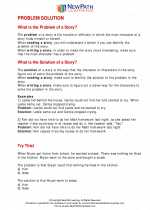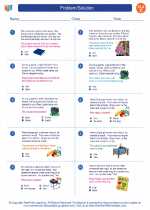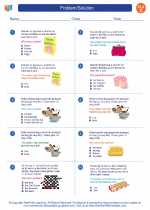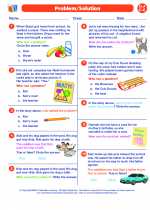Problem/Solution Study Guide
Problem/Solution is a type of text structure where the author presents a problem and offers one or more solutions to solve it. This type of writing is commonly found in persuasive essays, opinion pieces, and informational texts.
Identifying Problem/Solution Texts
To identify a Problem/Solution text, look for the following clues:
- Introduction of a problem or issue
- Presentation of one or more solutions
- Use of signal words such as "problem," "issue," "solution," "solve," "address," etc.
Understanding the Structure
The structure of a Problem/Solution text typically follows this pattern:
- Introduction of the problem or issue
- Description of the effects or consequences of the problem
- Presentation of one or more solutions
- Explanation of how each solution addresses the problem
- Conclusion or call to action
Practice Questions
Here are some practice questions to test your understanding of Problem/Solution texts:
- What is the purpose of a Problem/Solution text?
- How can you identify a Problem/Solution text?
- What are the key components of the structure of a Problem/Solution text?
- Can you provide an example of a signal word that might indicate a Problem/Solution structure?
Remember, when reading Problem/Solution texts, pay attention to the problem being presented and the proposed solutions, and consider the effectiveness of the solutions in addressing the problem.
[Problem/Solution] Related Worksheets and Study Guides:
.◂English Language Arts Worksheets and Study Guides Third Grade. Problem/Solution
Study Guide Problem/Solution
Problem/Solution  Worksheet/Answer key
Worksheet/Answer key Problem/Solution
Problem/Solution  Worksheet/Answer key
Worksheet/Answer key Problem/Solution
Problem/Solution  Worksheet/Answer key
Worksheet/Answer key Problem/Solution
Problem/Solution  Worksheet/Answer key
Worksheet/Answer key Problem/Solution
Problem/Solution 

 Worksheet/Answer key
Worksheet/Answer key
 Worksheet/Answer key
Worksheet/Answer key
 Worksheet/Answer key
Worksheet/Answer key
 Worksheet/Answer key
Worksheet/Answer key

The resources above cover the following skills:
Standards for Reading Literature (RL)
Key Ideas and Details
Anchor Standard: Determine central ideas or themes of a text and analyze their development; summarize the key supporting details and ideas.
Recount stories, including fables, folktales, and myths from diverse cultures; determine the central message, lesson, or moral and explain how it is conveyed through key details in the text.
Restate, retell, paraphrase, and/or summarize the text and/or parts of the text either orally or in writing (See CCSS RL.4.2; W.4.9; SL.3.4, 6): Differentiate between key and minor details and events from the beginning, middle, and end of a literary text (See CCSS RI.3.2); Identify and explain the elements of a story (e.g., character(s), setting, problem, solution, sequence of events); Identify and explain plot-based relationships, including sequence/chronology, problem/solution, cause/effect (See CCSS RI.3.2).
Craft and Structure
Anchor Standard: Analyze the structure of texts, including how specific sentences, paragraphs, and larger portions of the text (e.g., a section, chapter, scene, or stanza) relate to each other and the whole.
Refer to parts of stories, dramas, and poems when writing or speaking about a text, using terms such as chapter, scene, and stanza; describe how each successive part builds on earlier sections.
Explain the relationship between events in different parts of a literary text (e.g., cause/effect, problem/solution).